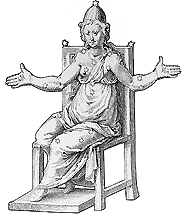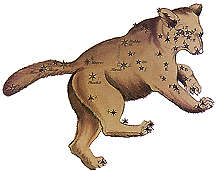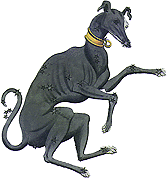![]()
Star watching has occupied humans from the earliest times. Our ancestors studied the night sky and saw shapes and patterns among the stars. They often made up stories to explain what they saw. The same star constellation was seen very differently by people from different countries, or even different parts of the same country. When looking at the constellation Capricornus, for example, the ancient Aztecs saw Cipactli, the Whale. In India, Makaram, an antelope, was seen in the same constellation. The Assyrians thought the constellation looked more like a goat-fish while the ancient Greeks thought it appeared to be a gate for the the Gods to pass through. Below you will find a collection of constellation myths from different cultures as well as pictures of the star patterns which inspired them. Read the myths, then match each with the star picture you think it describes. Once you have finished, check to see which culture(s) saw the same constellations as you do.
 |
2. A Greek MythCassiopeia, a queen of ancient Ethiopia, was a very beautiful woman. Unfortunately, she was also very vain and spent much of her time bragging about her beauty. She even boasted that she was far more beautiful than the maidens who attended Poseidon, the god of the sea, in his underwater kingdom. When Poseidon's maidens learned of this, they were very angry indeed. The maidens demanded that Poseidon punish Cassiopeia for daring to compare herself to them. Poseidon agreed that Cassiopeia should be punished. He placed her in the heavens to be scorned, not honored. Cassiopeia swings every half night around the North Star. She is seated in a chair, but the chair is placed upside down. Cassiopeia must hang on with both hands to keep from falling out. Her sky position is most humiliating for one who was so proud of her beauty. |
3. A Woodland Indian MythLate in the spring, a bear awakened from its long winter sleep and wandered out of its hillside den in search of food. Soon three hunters spotted the bear and began to chase it. Just like the bear, the hunters were hungry after the long, cold winter. The first hunter carried a bow and arrow with which he hoped to kill the bear. The second hunter carried a big pot in which he hoped to cook the bear. The third hunter came behind the others. He was collecting wood for the huge fire which would be needed to cook such a large meal. All summer the hunters chased the bear through the sky. In the fall, the bear started to get weak and the first hunter was able to shoot it with an arrow. The arrow killed the bear and it fell over on its back. The hunters ate the bear and left its skeleton behind. As fall turned to winter, the weather became colder and colder. The bear's skeleton was still visible in the sky, but the life spirit of the bear had entered a new body -- the body of another sleeping bear. All through the long, cold winter the bear slept. When spring came again, the bear awakened and went out in search of food. Once again it was hunted and killed. Its life spirit entered the body of yet another sleeping bear in the den. And so it happens every year. |
 |

"I cannot do that," said Yudistira. "I do not wish for any happiness for which I must leave so dear a companion."
"You traveled on without your four brothers," said Indra. "Why will you not ascend to heaven without your dog?"
"My lord," replied Yudistira, "my brothers left me to follow the desires of their hearts. Svana has given his heart to me. Rather than renounce him, I must renounce heaven."
"You have spoken well," said Indra. "Come in, and bring your dog with you." So Yudistira and Svana ascended into paradise. In recognition of their devotion to one another Indra set in the sky the constellation of the Great Dog whose star Sirius is the brightest of them all.
Pictures of: Ursa Major, Cassiopeia, Canis Major, and Corona Borealis
![]()
The StarChild site is a service of the High Energy Astrophysics Science Archive Research Center (HEASARC), within the Astrophysics Science Division (ASD) at NASA/ GSFC.
StarChild Authors: The StarChild Team
StarChild Graphics & Music: Acknowledgments
StarChild Project Leader: Dr. Laura A.
Whitlock
Curator:
Responsible NASA Official: